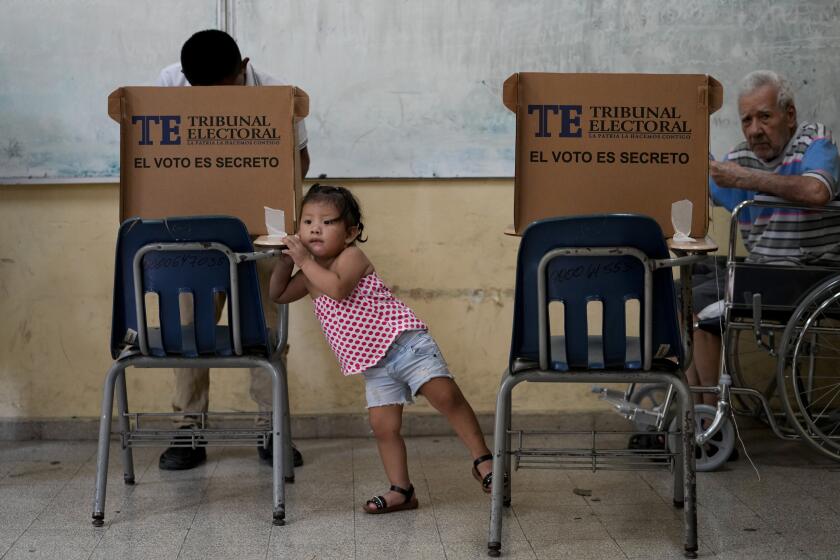Warlord Gets Warning as Marines Arrive
The sharply dressed Belgian colonel was diplomatic, but the meaning was clear to the local warlord, a cane-carrying little man in a baggy shirt who calls himself the regional military chief. “If your armed vehicles move, they will be destroyed,” the colonel said.
The encounter was between Col. Marc Jacquemin, who is commander of a coalition force made up of 180 U.S. Marines and 90 Belgian paratroopers, and Omar Jess, who calls himself “a colonel of the Somali National Army.”
They had come together to discuss security arrangements after the speedy, overwhelming and uneventful occupation of this port city in southern Somalia by the coalition force early Sunday.
According to Capt. Mark Lane, head of the reinforced Marine company that spearheaded the amphibious landing, it took three hours to secure the target areas, principally the port and the airport across the city.
At that point, he and his security aide, Lt. Mike Aubut, escorted Jacquemin and an American Army adviser into the compound used as a headquarters by Jess.
“What we saw when we drove into the compound was startling,” said Lane, 30, of Huntington Beach, Calif. “There were five ‘technicals’ (pickup trucks and other vehicles equipped with heavy arms) with .50-caliber machine guns and even a rocket launcher armed with 16 large rockets.”
Aubut said no threatening gestures were made, but technicals like those encountered here Sunday worry the U.S.-led troops everywhere in Somalia because they could do serious damage if they were used to attack what is still a small and stretched-thin force.
So, when the Americans and Jacquemin reached the roof of Jess’ three-story headquarters, the technicals were the first item on the agenda, said Lane, who listened to the discussion.
“The meeting was friendly; it had been prearranged. Col. Jacquemin was polite, more diplomatic than I would have been, but we made it clear that if the technicals left the compound they would be destroyed.”
Friendly in tone, perhaps, but as they talked Aubut found himself confronted by five Somalis armed with AK-47 assault rifles. “They didn’t raise their weapons, but I kept them covered. It was a nervous time.”
An aide to the Belgian commander, Lt. Col. Ben Blys, said later that Jess, whose forces are believed to have killed 60 to 100 people in a last-minute looting and murder spree before the Marines and Belgian troops arrived, indicated he understood Jacquemin’s statement and agreed.
At a second meeting late Sunday afternoon, Jess, whom Aubut described as “not what I would call a military leader,” lectured the Belgian commander “on the history of colonial occupation.”
However, the Marines were enthusiastically welcomed from the moment they hit land. “They (local citizens) waved, they screamed, they danced, they even went to the beaches to celebrate,” said Sean Devereaux, head of the local U.N. Children’s Fund office, who witnessed the day’s events.
“It was a great thing,” the Irish relief worker said. He described Jess as the leader of a clan that has terrorized the region for two years as part of a civil war “that has led to the famine.”
The Kismayu region is, indeed, lush. Its rivers are full to flooding from recent rains. Yet 63,000 of the region’s population of 160,000 are displaced, and until recently 300 people a day were dying of starvation.
“It is a man-made famine,” said Devereaux. “Famine caused by civil war.”
Devereaux also pointed out what he sees as a significant problem with Operation Restore Hope, as the U.N.-sanctioned relief effort in Somalia is called. As it stands, he said, the U.S.-led forces are not allowed to disarm any Somalis unless they directly threaten or attack the foreign troops.
The policy also allows such clan leaders as Jess to keep their technicals and their weapons if they store them or move them out of populated areas, Devereaux said.
If nothing changes, he added, there is no barrier to resumption of murderous clan warfare once the U.S. and other combat troops leave except the hope that a political settlement can be arranged.
“It is vital that they (the foreign forces) address the question of disarmament,” said Devereaux.
Meantime, the delivery of food to the suffering began to develop in impressive fashion.
A convoy of 20 trucks carrying 300 tons of rice and 20 accompanying military vehicles, with helicopter gunships overhead, made a long drive from the capital of Mogadishu to the interior city of Baidoa, another site of intense suffering.
There was no resistance other than giant potholes and mechanical troubles, and relief officials said the convoy “is a real breakthrough in getting food to starving people.”
And here in Kismayu, the first relief flight to reach the city in more than 10 days landed at 11:15 a.m., less than five hours after the first Marine amphibious landing craft roared out of the Indian Ocean.
By the end of the day, three giant cargo planes carrying up to 150 tons of food each had landed at Kismayu’s war-wrecked airport.
No resistance occurred, Lane said, but he noted that a column of technicals was only 20 miles away and that there were reports of another so-called “Somali army” about the same distance away.
The possibility of armed encounters by U.S. forces and Somalis gained reality Sunday night when a Marine patrol in Mogadishu came face to face with a pickup carrying a .50-caliber machine gun mounted on the roof.
When the Marines thought they saw the gun barrel swinging toward them, two troopers opened fire with M-16 assault rifles. They reported seeing one man slump out of sight as the pickup escaped into the crooked and darkened streets.
The next step here in Kismayu, according to Marine officials, is for their force to ensure the security of the whole area. When that is completed, probably in the next two or three days, they will return to their seagoing task group and be replaced on the ground by U.S. Army personnel.
Once the soldiers have widened the area of occupation and institutionalized the food distribution system, they will be replaced by other coalition members acting as a U.N. peacekeeping force.
That, in miniature, is the overall program, which has been laid out in four stages: Occupy Mogadishu; spread inland to Baidoa and another famine center, Bardera; liberate Kismayu and establish secure feeding and distribution sites there and in seven other centers nationwide, and, finally, turn over the operation to U.N. peacekeepers.
U.S. military spokesmen say that the program has reached the third stage and that they think the whole operation can be completed within three or four months.
However, Bardera has not been reached yet, and there are reports in the countryside of growing opposition to the foreigners’ presence by Muslim fundamentalist clergymen, who are strong in rural areas.
More to Read
Start your day right
Sign up for Essential California for news, features and recommendations from the L.A. Times and beyond in your inbox six days a week.
You may occasionally receive promotional content from the Los Angeles Times.






